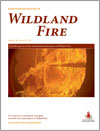International Journal of Wildland Fire
Volume 26
Number 8 2017
Data compiled from reports of firefighter entrapments in the USA were used to build statistically based models of wildland firefighter safety and survival zone separation distance. Model results reinforced the importance of fire shelters and produced predictions of separation distance from flames that in some cases were significantly greater than suggested by physically based models.
Methods for remotely measuring Byram’s fire intensity with infrared cameras are developed. Experimental data are collected to validate the methods. Results suggest it is possible to use infrared imagery to quantify fire intensity without the need for ground sampling.
Several types of wind shifts dangerous to wildland firefighters derive from convective downdrafts and outflows. A climatological summary of the potential for evaporation-driven downdrafts in the continental United States is presented, with discussion of implications for forecasting and operations.
Using a unique fire whirl facility made of an air curtain apparatus, the correlation of the flame emissivity of fire whirl with flame diameter was determined by an infrared method for the first time. It was verified that the flame radiation of the fire whirl can be accurately predicted by the multizone flame model with the use of the measured flame emissivity.
Fire spread is integrated with an eco-hydrological model designed to predict physical and biological watershed dynamics. The challenges of matching the requirements of predicting fire spread with the outputs of a model not designed for fire are evaluated and overcome in model design.
Interviews with fire operations personnel reveal 10 simplifications in official guidance about radio communication. Recommendations are offered for research, practice and training.
This paper examines wildfires reported in the NFIRS database, a primary database for fires in the US, and compares it with the satellite-based MODIS fire detection data and the CAL FIRE FRAP geodatabase to understand underreporting of wildland fires. The paper discusses a series of large wildland fires and uses a Generalised Linear Model to identify the conditions where large wildfires go unreported.
Wildfires represent a threat to many communities nationwide. Random parameter logit model results suggest that Florida minority homeowners who perceived they live in low- to moderate-risk communities prefer both types of fire mitigation programs. In addition, homeowners who perceived they live in high-risk communities also prefer both the public and private programs, but their WTP values are lower than in low- to moderate-risk communities.




